
| Nahuel Huapi Traverse (Part 2) |
Day 5 - Pampa Linda to Refugio Otto Meiling |
|
|
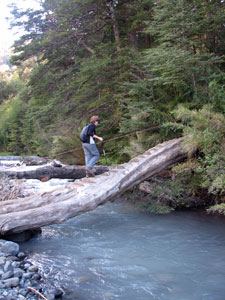 Crossing the Rio Castaño Overa |
The track across the flats was well-formed and well-used, and our only stop was to adjust the dressing on the poor Nello's badly blistered heels (not only is she good looking, she is also tough!). Soon we arrived at a log bridge across the Rio Castaño Overa and, once on the other side, started our climb up the side of one of the spurs of Tronador, gently at first on the road through the tall, dark coihue forest with its bamboo understorey, then more steeply as the walking track cut the corners of the road and finally climbed steeply up a series of zig-zags through lenga forest. Eventually it flatted out somewhat on rounded ridge of lichen-covered stunted lenga - we had reached La Almohadilla (the little pillow). |
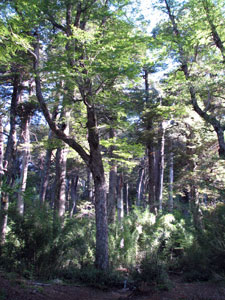 Back in the forest |
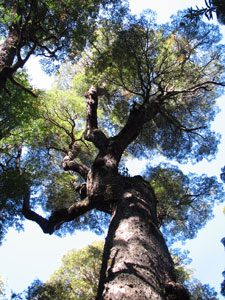 Canopy of a large coihue (beech) tree |
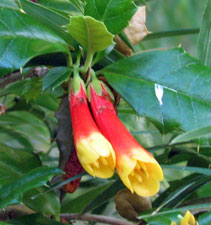 |
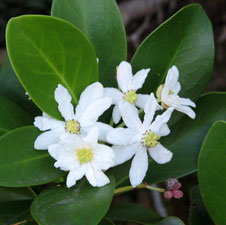 |
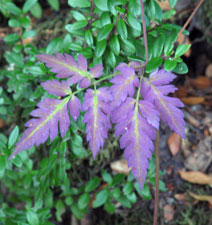 |
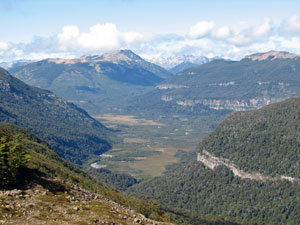 Looking back down the valley toward Pampa Linda |
Continuing on along the ridge of the spur, we again climbed steadily through the lenga, reaching the treeline at around 1700m. The altitudinal changes in vegetation were becoming familiar to us. On this ridge vegetation gave way to a the scoria and basalt rock jumble of the ridge - reinforcing the fact that we were on the slopes of a volcano. At one time this would not have been a very pleasant place to be - but today was not such a time. |
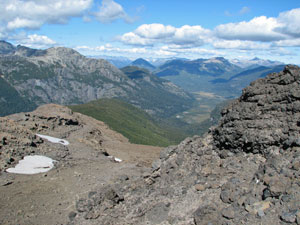 Looking across the basalt and scoria of the lava ridge |
The weather was superb - clear blue skies, a crisp breeze and magnificent views unfolding as we slowly climbed higher; the dramatic 400m waterfalls tumbling down from the face of the Castaño Overa Glacier to the left of the ridge and the crevassed slope and broken face of the Alerce Glacier to the right. Behind us lay the beautiful green valley that we had just walked up, stretching back to Pampa Linda. Just as we passed the black volcanic plug of Morenkopf, we saw our first condor soaring high above the ridge - a perfect day! |
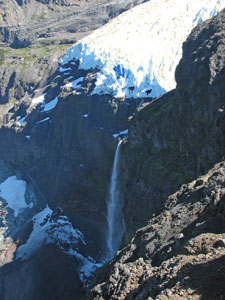 The 400m waterfall thundering down from the base of the Castaño Overa Glacier |
|
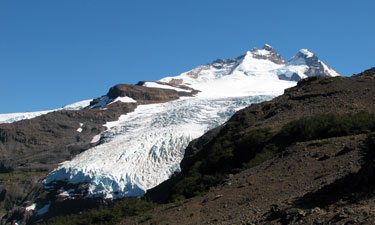 The Castaño Overa Glacier beneath the Pico Internacional (3484m) and Pico Argentino (3187m), two of the peaks on Monte Tronador |
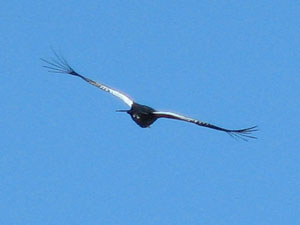 El condor pasa! |
|
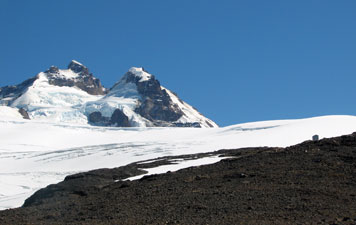 Spot the refuge building dwarfed beneath the peaks of Tronador |
Pushing on, up the jagged lava slope, we caught our first glimpse of the buildings of Refugio Meiling, silhouetted against the snow and dwarfed by the peaks of Tronador. A little later and we were there, three and a half hours and 1000m from where we had set off.
Soon we were sitting in the warm refuge enjoying a cup of hot soup and a sandwich for lunch, as we listened to the sounds of Argentine country music. Out through the refuge windows, the Argentine army were building igloos on the glacier below the icy peaks of Tronador, now only a few kilometres away - at Otto Meiling the food is good, the music pleasant, the guardians friendly and the views superb. |
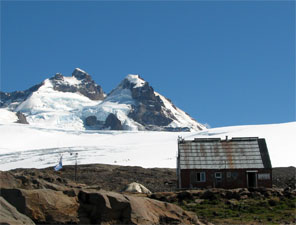 Refugio Otto Meiling beneath the peaks of Monte Tronador |
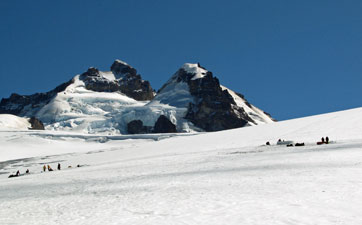 The Argentine Army playing in the snow beneath the peaks of Tronador |
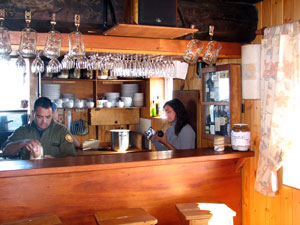 Inside warm and friendly Refugio Otto Meiling |
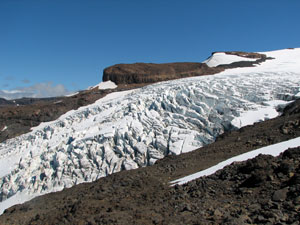 Looking across the fall of the Castaño Overa Glacier to Piedra de Perez |
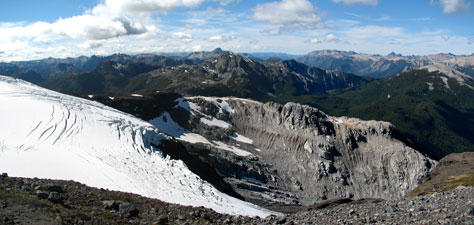 Face of the Alerce Glacier and mountains to the north of the refuge |
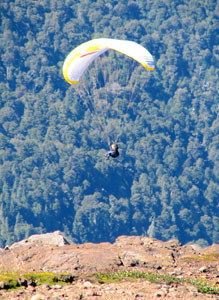 Not only condors soared by! |
Lunch over, there was still time for a stroll up to the snowline at 1960m, from where you could look down on to the deep crevasses of the two glaciers on either side of the ridge, and across the valley to our path of the past few days; Laguna Ilon in its beech-filled basin and the high barren ridges of the mountains we had crossed, capped by the jagged spires of Cerro Catedral in the far distance. Our traverse of the Nahuel Huapi National Park now felt complete. Two more condors soared overhead and, to our surprise, a paraglider drifted by beneath. Condors, crevasses, paragliders, snow-capped volcanoes, deep valleys, jagged ranges - this as a very special place and it was sad when the time came to leave. |
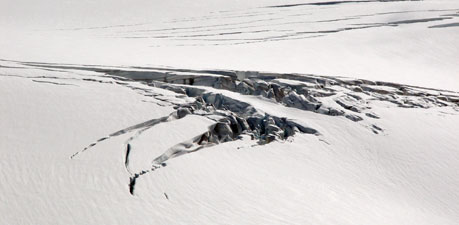 Crevasse in the Alerce Glacier |
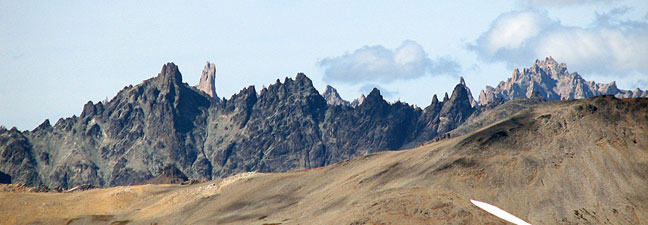 Panorama of the jagged ridges and needles of the Parque Nacional Nahuel Huapi viewed from Refugio Otto Meiling
|
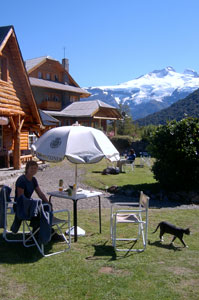 A well-earned cerveza at the albergue |
|
|
A bike ride to Ventisquero Negro
|
||
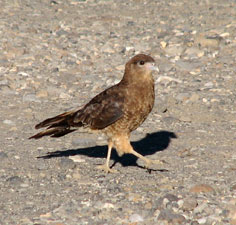 Caracara |
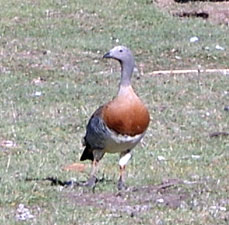 Caiquen (Pataganonian goose) |
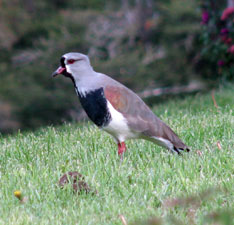 Patagonian lapwing |
 Sometimes wheels are better than feet |
|
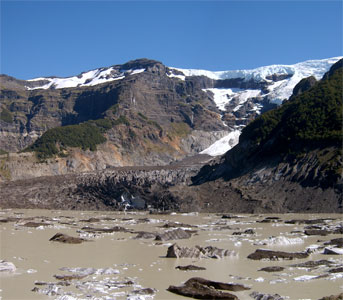 Ventisquero Negro and the Manso Glacier in their magnificent setting |
|
The face of the black glacier, so-called because of the rock and moraine rubble accumulated in it through thawing and refreezing, lay across a frozen lake, the colour of weak coffee, filled with icebergs of every size and shade from white to black. It was an impressive sight. A loud rumble attracted our gaze several hundred metres higher - a large block of frozen snow had broken free from the face of the Manso Glacier, precariously overhanging the cliff, and crashed down below. It became obvious why this mountain is called Tronador (Thunderer).
|
The snow and ice chutes from the glacier-lined high cliffs of Tronador would accumulate and reform into the black ice of the Ventisquero Negro in the valley below. We sat there for an hour, watching and listening to several other snow-ice chutes, soaking up the atmosphere and the autumn sun. |
|